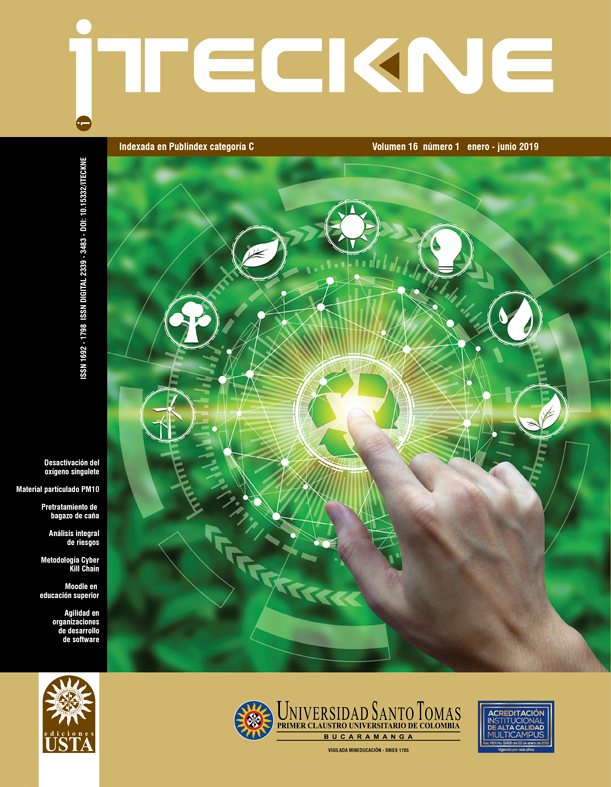Creation of a DDOS attack using HTTP-GET Flood with the Cyber Kill Chain methodology
Abstract
This article illustrates by means of a demonstration and taking advantage of the vulnerability “Open redirect”, how easy it can be to attack web servers through distributed attacks of denial of services. In it, the Cyber Kill Chain® model is used to carry out this attack in phases. In the development of the research, a systematic UFONet tool is applied and the results obtained are analyzed and it is recommended to protect the Internet application services of said attacks through web application firewalls (WAF) whose presence allows the DDoS traffic of the application layer (including the HTTP-GET flood) arrives effortlessly at the destination server.
Downloads
References
[2] A. F. A. Rahman, M. Daud, and M. Z. Mohamad, “Securing Sensor to Cloud Ecosystem using Internet of Things (IoT) Security Framework,” in Proceedings of the International Conference on Internet of things and Cloud Computing - ICC ’16, 2016, pp. 1-5.
[3] T. Yu, V. Sekar, S. Seshan, Y. Agarwal, and C. Xu, “Handling a trillion (unfixable) flaws on a billion devices,” in Proceedings of the 14th ACM Workshop on Hot Topics in Networks - HotNets-XIV, 2015, pp. 1-7.
[4] J. Martínez, J. Mejía, and M. Muñoz, “Análisis de la seguridad en Internet de las cosas: Una revisión sistemática de literatura,” IEEE.
[5] T. Olavsrud, “CIO,” CIOs should step into the IoT oversight void, 2017. [Online]. Available: https://www.cio.com/article/3202398/leadership-management/ciosshould-step-into-the-iot-versight-void.html. [Accessed: 23-Jun-2017].
[6] I. Arbor Networks, “Digital Attack Map,” 2017. [Online]. Available: http://www.digitalattackmap.com/. [Accessed: 30-Oct-2017].
[7] E. Filiol, “Viruses and Malware,” Handb. Inf. Commun. Secur. Part F, pp. 747-769, 2010.
[8] A. M. del Rey, “Mathematical modeling of the propagation of malware: A review,” Security and Communication Networks, vol. 8, no. 15. pp. 2561-2579, 2015.
[9] Cisco, “The Evolution of Malware,” no. January, 2017.
[10] S. McGregory, “Preparing for the next DDoS attack,” Netw. Secur., vol. 2013, no. 5, pp. 5-6, May 2013.
[11] K. Singh, P. Singh, and K. Kumar, “Application layer HTTP-GET flood DDoS attacks: Research landscape and challenges,” Computers and Security, vol. 65. pp. 344-372, 2017.
[12] D. Kostadinov, “Layer Seven DDoS Attacks.” [Online]. Available: https://resources.infosecinstitute.com/layer-seven-ddos-attacks/. [Accessed: 29-Nov-2018].
[13] V. Zakharevich, “Understanding and Discovering Open Redirect Vulnerabilities,” 2017. [Online]. Available: https://www.trustwave.com/Resources/Spider- Labs-Blog/Understanding-and-Discovering-Open-Redirect-Vulnerabilities/. [Accessed: 29-Nov-2018].
[14] “LOIC download | SourceForge.net.” [Online]. Available: https://sourceforge.net/projects/loic/. [Accessed: 30-Nov-2018].
[15] “High Orbit Ion Cannon download | SourceForge.net.” [Online]. Available: https://sourceforge.net/projects/highorbitioncannon/. [Accessed: 30-Nov-2018].
[16] “UFONet - Denial of Service Toolkit.” [Online]. Available: https://ufonet.03c8.net/. [Accessed: 30-Nov-2018].
[17] “Dirt Jumper - Krebs on Security,” [Online]. Available: https://krebsonsecurity.com/tag/dirt-jumper/. [Accessed: 30-Nov-2018].
[18] “Torshammer download | SourceForge.net.” [Online]. Available: https://sourceforge.net/projects/torshammer/. [Accessed: 30-Nov-2018].
[19] “Nuclear DDoser ~ Hacking.” [Online]. Available: http://anonganesh.blogspot.com/2014/03/nuclear-ddoser.html. [Accessed: 30-Nov-2018].
[20] “Cyber Kill Chain® | Lockheed Martin.” [Online]. Available: https://www.lockheedmartin.com/en-us/capabilities/cyber/cyber-kill-chain.html. [Accessed:29- Nov-2018].
[21] “Intelligence Driven Defense® | Lockheed Martin.” [Online]. Available: https://www.lockheedmartin.com/en-us/capabilities/cyber/intelligence-driven-defense.html. [Accessed: 29-Nov-2018].



















